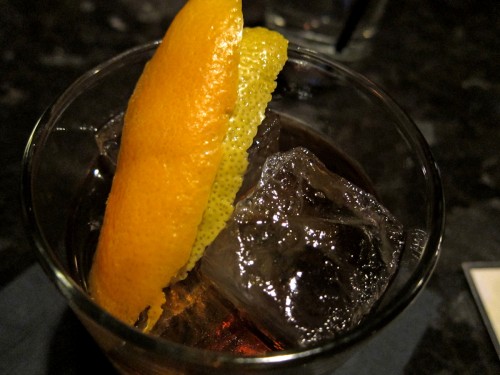The Negroni Variations, Part 1: Negroni’s Loss
I do love me a Negroni.
The bitterness of Campari sometimes scares folks away, but it shouldn’t — it’s a bracing flavor that’s perfect for awakening your palate before a meal. It can be a bit much if the first time you try it is in a Campari and soda (wildly popular in Italy), but most places tend to serve it tall, in a highball or Collins glass. It works much better short, in nearly equal proportions with soda, to give the sugar in Campari a chance to balance out the bitterness. Too much dilution will tend to let the bitter element take over the sweet. Remember, it’s all about balance. (I prefer my Americanos short too.)
My first introduction to Campari was in the entertaining Combustible Edison cocktail, in which an ounce each of Campari and lemon juice are shaken and strained into a cocktail glass, and then two ounces of warmed Cognac are flamed and poured in a flaming stream into the glass. Entertaining indeed, but not my favorite. Many folks’ introduction to Campari is by mixing it with orange juice, about double juice to spirit, perhaps with a splash of soda or tonic. I’d have to pick the Negroni as my favorite, though, and if you haven’t tried it you should. As with most adult tastes, it’s one worth acquiring.
The drink we know as the Negroni has had various names; the Camparinette is perhaps the most well-known, and according to Andrew the Alchemist it was also called the Cardinale in Italy. It dates back to as early as 1919, although what the Italians were calling a “Negroni” then would seem more like an Americano with gin to us.
All this has evolved into the classic Negroni proportion we’ve come to know — equal parts gin, sweet vermouth and Campari. That can be a bit sweet for some people, and I’ve seen many variations on the proportion — typical is 1-1/2 gin, 1 Campari and 3/4 vermouth, to keep the sweetness at bay. I’ve also been fond of the Cinnabar Negroni, in which the Campari is doubled and orange bitters added.
The basic Negroni formula lends itself quite nicely to variation of spirits and even in the bitter element, despite Campari seeming quintessential to the drink. I’ve sampled many lovely versions that take the gin-Campari-vermouth formula to something more like spirit-bitter-aromatized wine. Aperol is a natural substitute for the Campari, but other interesting bitters outside the dark Italian amaro field have popped up recently. One of my favorites is the Swiss-made bitter called Gran Classico Bitter, based on a recipe from Turin from the 1860s. It contains bitter orange, gentian, rhubarb and wormwood among its botanicals. It’s got quite a bitter punch, not unlike Campari but with a less bright, rounder, deeper flavor. It’s being directly marketed as a Campari substitute, even recommending its use in cocktails like the Negroni, Americano or spritzer.
Jason Schiffer at 320 Main in Seal Beach, CA uses Gran Classico in one of my favorite recent twists on the Negroni, swapping the gin for its malty progenitor, Dutch genever, and bringing down the other two components. The maltiness of genever with the citrus oils accenting the citrus notes in the bitter work beautifully here; this one didn’t last long the last time we visited 320. They’ve just changed their menu and this cocktail isn’t on it anymore, but they’d still be happy to make you one. If you’re in Southern California, and especially if you’re in Orange County, you need to drink here — it’s the best place to get a drink for many miles. The food’s terrific, too. Duck mac ‘n cheese? Oh my.
NEGRONI’S LOSS
(320 Main, Seal Beach, CA)1 ounce Bols Genever.
3/4 ounce Carpano Antica sweet vermouth.
3/4 ounce Gran Classico bitter.
Lemon and orange peel & oils.Combine with ice and stir for at least 30 seconds. Strain into an Old Fashioned glass. Express the oil from the lemon and orange peels onto the surface of the drink, and garnish with the peels.
Now, moving on from “Holland Gin” to another older style of gin for our next drink …






